Mole, nevus, birthmark - all these are names of benign pigmented formations on the human skin. Moles can be present on the skin from birth or appear throughout life, be of various colors (from light brown to black), raised above the skin or be completely flat - no matter what the nevi are, they are safe until they begin to degenerate into melanoma - cancer skin. Black moles on the body are especially prone to such degeneration in the presence of favorable conditions.
Causes
The cause of the most common mole is an excess of melanin pigment in the skin, which leads to the growth of melanocyte cells, their concentration is called a nevus.
As for black moles on the body, there are many more reasons for the appearance of these formations.
Why moles darken:
- Direct exposure to sunlight. Ultraviolet radiation contributes to the appearance of both new birthmarks and a change in the color of existing ones, up to black.
- Changes in hormonal levels. Many black moles on the body may appear during pregnancy or during puberty.
- Systematic mechanical damage to the skin. This problem is typical for moles that are located in places that are constantly exposed to shaving and friction with clothing. It is recommended to remove such formations after consultation with a doctor.
- Hereditary factor. It is rare to see a mole on the body of a newborn. There is a version that they are simply negligible to be seen with the naked eye. But already at 2-3 years of life, nevi may appear on the child’s body. And if one of the parents has black moles on the body, the baby may also have them black.
- Bacterial or viral skin diseases.
- Exposure to x-rays or radiation.
If one of the black moles on the body has darkened even more for no reason, this is a reason to immediately contact an oncodermatologist.
Safe nevi
There are several classifications of moles, depending on the time of their appearance, color, size and appearance.
Black moles on the body are divided into:
- Flat. The most common formations do not cause concern if they are initially black. If the nevus has acquired a black color under the influence of any factors or for no reason at all, you must consult a doctor for diagnosis.
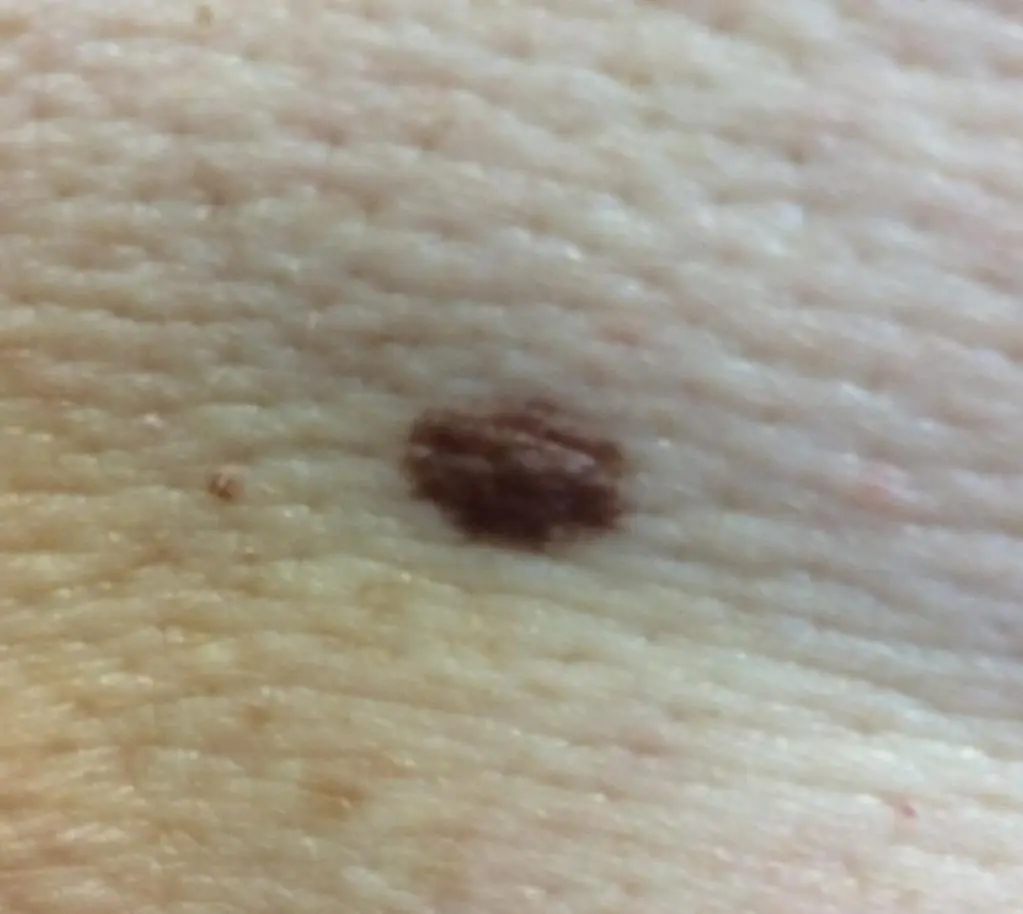
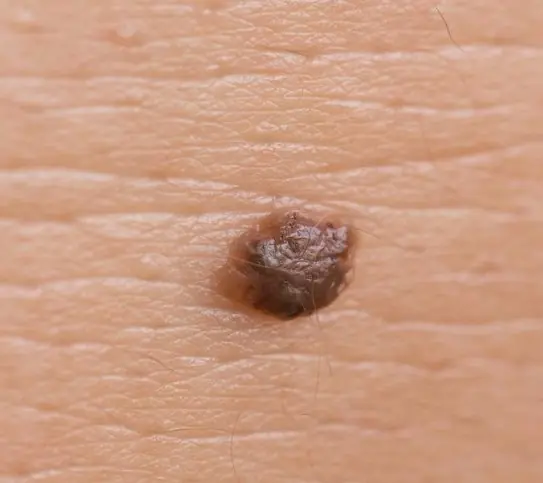
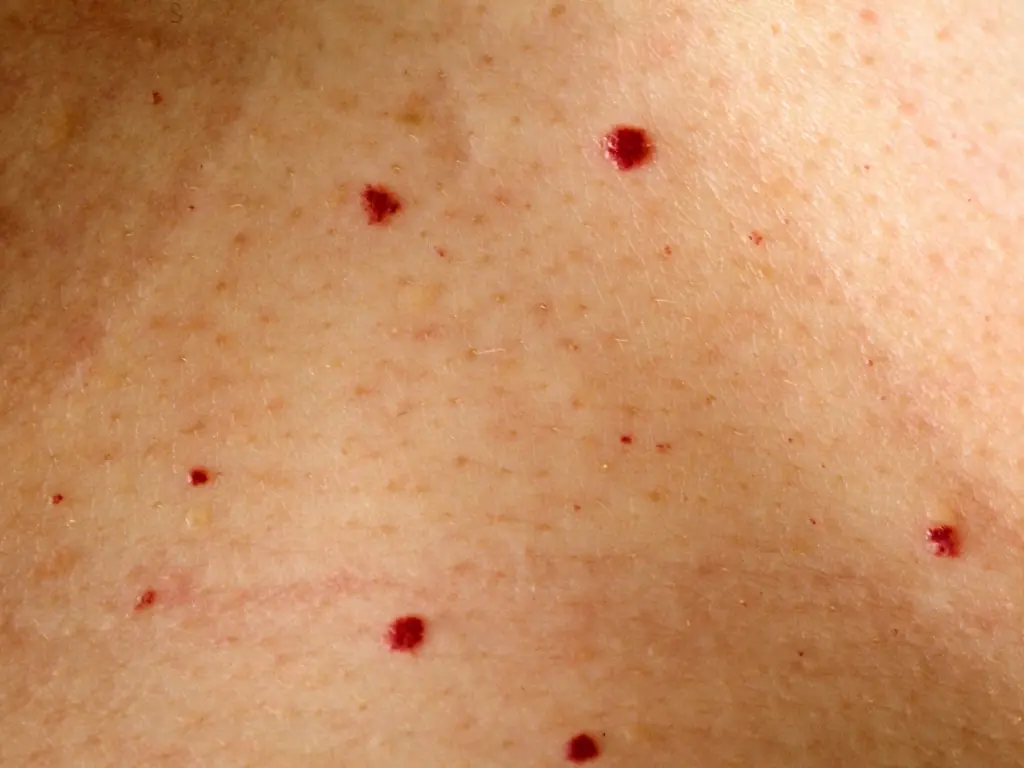
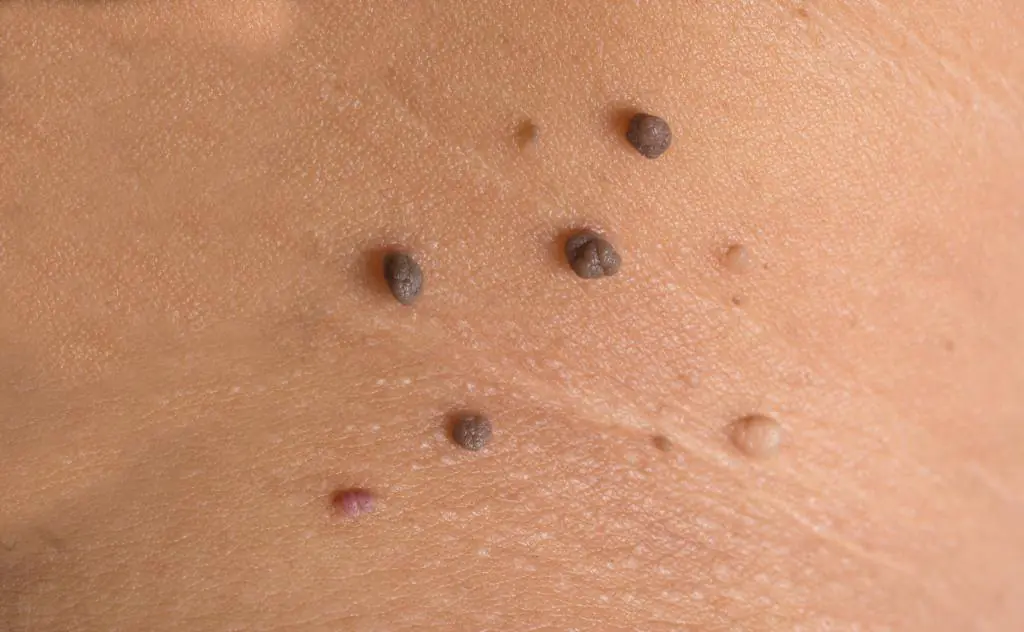
All of these moles are benign provided they have:
- diameter less than 0.5 cm;
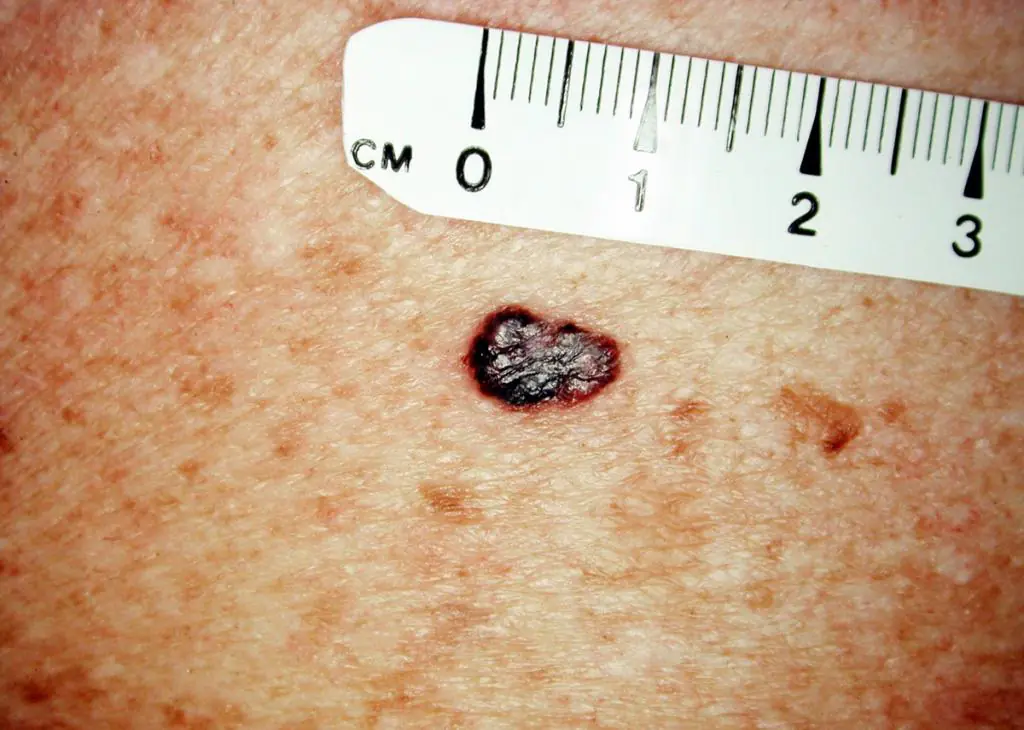
- clearly defined oval or round shape;
- smooth surface.
Any deviation from the norm, even one black mole on the body, is a reason to visit a medical facility.
Suspicious moles
In addition to ordinary moles that do not cause concern to their owner, there are several types of nevi that can be dangerous not only to health, but also to human life.
- Dysplastic moles - characterized by black color, large diameter (over 5 mm), uneven contours, uneven color, and may be convex.
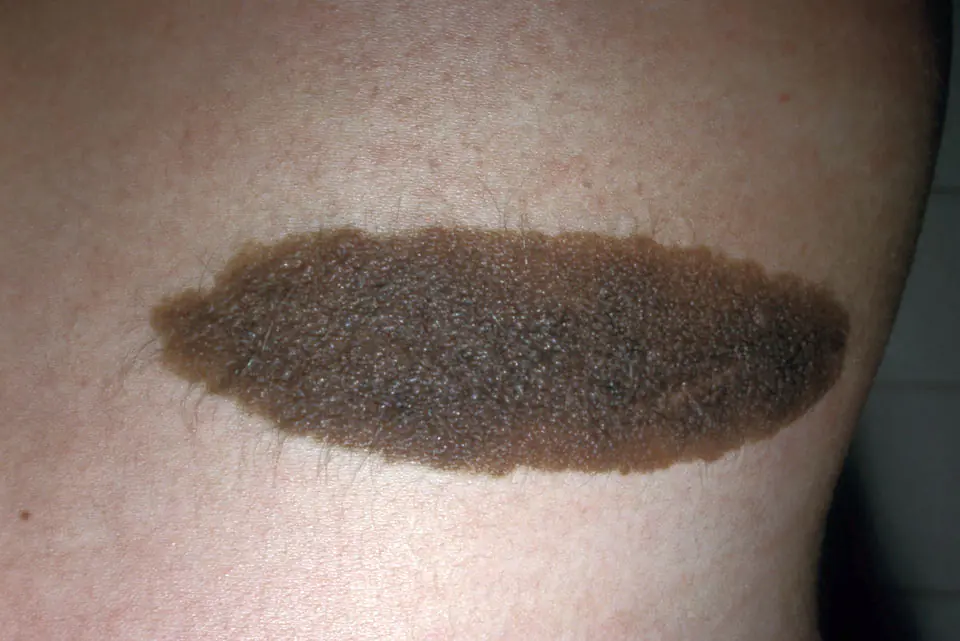
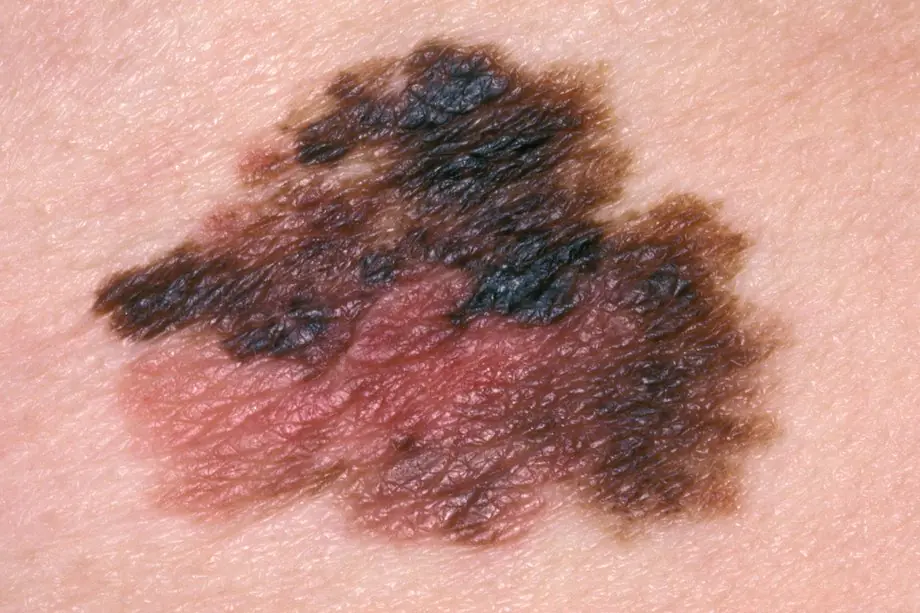
If there is the slightest suspicion of nevus degeneration, it must be remembered that early diagnosis of melanoma can save life.
Critical symptoms
Sometimes black moles on the body are located in such places that it can be difficult to independently assess their appearance. In such situations, other symptoms of a change in the mole should alert the owner.
Symptoms of nevus degeneration:
- bleeding from a mole;
- burning sensation, itching;
- loss of hair growing from the formation;
- the appearance of inflammation and ulcers;
- The surface of such a mole is rough to the touch, you can feel the scales.
Particular attention should be paid to moles that appeared after the age of 35.
Self-diagnosis methods
To make it easier for patients to remember what to pay attention to when observing nevi, doctors formulated the so-called FIGARO rule, which got its name from the first letters of 6 points that indicate a change in a mole.
- shape - the formation is raised above the level of the skin;
- change in the size of the nevus, noticeably accelerated growth rate;
- the boundaries of the mole are unclear;
- asymmetry - the 2 halves of the nevus differ from each other;
- size exceeds 0.5 cm;
- the color changes - multi-colored dots are added, and may become completely discolored.
To make it easier to track possible growth and changes in color of skin tumors, it is recommended to independently measure and record their diameter and take photographs.
Establishing diagnosis
If a black mole appears on the body, you cannot limit yourself to self-diagnosis. Considering the danger of melanoma, only a doctor can make a correct diagnosis and decide whether to remove a mole.
- interviewing the patient - the doctor needs to know whether the patient has been exposed to direct sunlight, whether there is a hereditary factor, what is his general condition;
- dermatoscopy - examination of skin tumors without surgical intervention;
- histology analysis - determining the presence of malignant cells in the formation;
- blood test for tumor markers;
- general blood and urine tests;
- biopsy - taking a sample of mole tissue for analysis.
If the degeneration of a mole into a malignant neoplasm is confirmed, other diagnostic methods (CT, MRI) are used to determine the stage of the disease, the activity of cancer cells, and the presence of metastases.
Treatment and observation
If the appearance of a black mole on the body poses a probable danger of the nevus to the life and health of the patient, the attending physician decides to remove the formation.
Mole removal methods:
- using liquid nitrogen, or cryodestruction - getting rid of pathological formations using ultra-low temperature;
- laser removal - gradual removal of pigmented tissues, the least traumatic method, often used on the face;
- electrocoagulation - electric cauterization, unlike laser, which is prohibited for dark skin, is suitable for any type of epidermis;
- excision with a radio knife, or radio wave method - the device does not contact the skin, leaving no traces;
- surgical removal - recommended only for malignant tumors, as it allows nearby tissue to be removed along with the melanoma to prevent relapse.
The method for removing a nevus is strictly individual and is selected by the attending physician based on the type of mole, the patient’s tests, the characteristics of his skin and the general state of health and immunity.
Risk group
There are groups of people who are especially susceptible to the degeneration of moles into malignant formations.
Risk groups include:
- people over 35 years of age who have new blackheads or moles on their body;
- patients whose number of moles exceeds 50, regardless of age;
- people with light skin, hair, eye color;
- owners of nevi susceptible to hereditary factors;
- people with weak immune systems.
To prevent the occurrence of melanoma, patients at risk are recommended to visit a dermatologist every 3 months, and for other owners of moles - annually.
Preventive measures
If a person has a tendency to form black dots on the body, similar to moles, it is especially important to adhere to the following recommendations in order to avoid their degeneration into oncology.
- Avoid exposure to direct sunlight, especially during the day when the sun is most active;
- do not visit the solarium;
- avoid mechanical damage to moles; if there are nevi in places of constant friction with clothing, razor trauma, it is recommended to remove such formations after consultation with a doctor;
- abandon synthetic materials that create a greenhouse effect and contribute to skin irritation;
- People with fair skin should avoid prolonged exposure to the sun, regardless of the time of day.
In addition to all of the above, treatment and removal of moles using traditional methods is prohibited. Self-medication can aggravate the problem and delay the moment of correct diagnosis and the start of life-saving therapy.
The pigmentation of a birthmark (nevus) depends on the degree of melanin concentration. Red formations are practically harmless and harmless to health. The brown color of the nevus in most cases indicates mechanical damage. Darker shades are acquired after exposure to excessive amounts of ultraviolet radiation. The appearance of a black mole indicates internal problems of the body. The presence of many such pathological formations is a serious reason to go to the doctor.
Reasons for appearance
An existing mole may change its original color to black under the influence of certain stimulating factors. This transformation is facilitated by the body's response - an excessive concentration of active melanin in organic skin cells.
Key factors influencing the occurrence and growth of dark pigmentation:
- Ultraviolet radiation. Prolonged exposure to the sun provokes the degeneration of melanin components into a malignant formation - melanoma.
- Fluctuations in hormonal levels. Physical changes in the body (pubertal development of a teenager, pregnancy, childbirth or PMS) under the influence of hormones are a favorable period for the development of a black nevus.
- Frequent physical damage to a brown mole leads to its darkening.
Skin formations on the legs (hanging) most often begin to turn black after an injury. An accidental tear of the leg prevents the full flow of blood into the neoplasm, which causes partial cell death. It manifests itself in the form of coloring in darker shades.
A black raised mole is practically no different from flat spots, but requires careful care and observation. The structure of the nevus is often subject to mechanical damage from clothing, shoes or friction. Harmful exposure makes the stain more susceptible to irritating environmental factors. Medical studies confirm that trauma to moles in 40% of cases is a stimulating cause of the formation of cancer cells.
Dangerous symptoms
The accumulation of the maximum concentration of the tint substance is characterized by gradual staining of the mole. The process begins with blackening of the center of the neoplasm, then the pigment spot spreads throughout the entire volume. Of course, a small black mole, resembling a dot, up to 4 mm in diameter, with a smooth surface does not look aesthetically pleasing, but it does not carry the risk of degenerating into cancer.
If a black mole or a small black spot appears on a mole, do not fall into premature panic. The process of formation of nevi in a newborn child begins from the moment of birth and ends by the age of 17 years. Therefore, it is believed that the resulting moles are benign. The influence of external irritating factors on the skin often causes the appearance of birthmarks on the body throughout life.
Rapid pigmentation with simultaneous growth of the rim and modification of the shape of the nevus requires immediate consultation with a dermatologist. Spontaneous drying and falling off of moles is a reason to consult a doctor. If an adult has many blackening spots on his skin, he also needs urgent consultation with a dermatologist and therapist.
Dangerous symptoms of malignant black moles:
- The surface of the skin pattern is smoothed, stretched, smooth.
- Asymmetry, visible signs of increase in size.
- Constant itching, sometimes internal burning in and around the spots.
- Scaly peeling of the nevus area, loss of hair growing from the formation.
- Bleeding.
- The presence of additional formations in the form of nodules on the surface.
If a mole begins to itch and pain appears in the area of the nevus, the doctor may suspect the onset of cellular transformation. Itching indicates the process of cell division and active growth. The growth of a mole from a centimeter or more indicates an unnatural pathology.
Frequent exposure to direct sunlight and visiting a solarium contribute to the proliferation of birthmarks. The appearance of a large number of dotted spots of a characteristic blackish hue is a signal of existing problems in the body.
Each of the nevi can be a sign of progression of malignancy.
Particular attention should be paid to existing black moles in a young child. Even a suddenly fallen nevus does not guarantee the absence of internal processes of malignant etiology. Since cancer symptoms are often hidden, the dried formation must be submitted for histological examination to determine possible pathologies.
Removal
The procedure for removing nevi is determined by medical necessity and is prescribed by a doctor. One of the significant reasons for prompt removal of a mole is its permanent damage. This occurs when the formation is localized on the leg, back, face, and side parts of the body. Areas of the shoulders and neck are subject to friction, which greatly irritates the organic tissue surface of the moles present there. The secretion of sweat glands often becomes a source of pain in the area of spots under the arms. Therefore, removing the pathological formation is a way to eliminate discomfort.
The operation is performed by a qualified specialist. Black moles on the back are removed using a radio knife or electrocoagulation. The procedure is virtually painless, does not require significant preparation and is performed under local anesthesia. The postoperative period is no more than two weeks. It is better to remove a black mole on the leg with a laser.
After these manipulations, there are no skin defects in the form of scars or cicatrices.
Independent removal of a mole is fraught with the introduction of infection into the wound with the subsequent development of malignant symptoms.
In case of positive histology, the patient goes under the supervision of an oncodermatologist, and removal is prescribed urgently. After a successful operation, the patient undergoes chemotherapy courses. Timely detection of dangerous signs of a malignant tumor is the key to successful recovery.
Conclusion
As a rule, if one birthmark has turned black, the situation is not dangerous. A healthy lifestyle, absence of bad habits, avoidance of excessive sun exposure and timely medical examination will significantly reduce the risk of developing melanoma.
A mole is a benign formation. The spots can be located on any part of the body of both an adult and a small child. If the mole has darkened, this indicates that a large amount of pigment, namely melanin, has begun to accumulate in it. Sometimes this may mean that there is a pathology in the human body. However, doctors who specialize in moles argue that a black mole does not always mean that a person has developed cancer.
Reasons for appearance
If a person has a black mole on his body, only a doctor can tell you what it is, whether it is dangerous, and what measures to take. It will also indicate that if the nevus is about 5 mm in size, its shape is correct, there is no bleeding, no roughness, then this formation is benign. There are cases when a black nevus forms in a baby at birth. This phenomenon indicates some characteristics of the body.
In order to understand why black dots appeared on a mole, you should consider some factors influencing this phenomenon. These include:
- Hereditary factor. Medical practice proves that birthmarks are inherited among close relatives. So, if one of the parents has a dark growth on the back, stomach or foot, the child has a formation with a similar localization.
- The influence of ultraviolet rays. Supporters of tanning under the scorching sun for a long time should remember that such a hobby contributes to the formation of new nevi, or the blackening of existing ones.
- Skin injury. If the mole turns black, it may indicate that a recent injury has occurred. Damage can be caused by scratching the growth, tearing or pressing hard.
- Hormonal imbalance. A change in the color of the formation can appear during pregnancy, during adolescence, when puberty begins. And also upon the onset of menopause, treatment with hormonal drugs, or the use of birth control pills.
Are black moles dangerous?
To protect yourself from the occurrence of cancer, you should regularly visit the office of a dermatologist or oncologist, and also independently monitor any changes in the black or blackened formation. It is important to remember what types of nevi there are in order to be able to distinguish a malignant formation from a regular nevus. These include:
- Small dark spot. In rare cases, it is dangerous to humans. Often its occurrence is associated with the systematic influence of certain factors. For example, ultraviolet rays. The neck, arms, legs, face, scalp, and back are exposed to ultraviolet radiation.
- Dysplastic mole. More dangerous than a regular nevus. It is formed on those areas of the skin that are not exposed to ultraviolet rays. They have a flat surface. Most often, their edges are uneven. The shade of this formation can vary from light brown to black. Rarely does a slight bulge occur.
- Melanoma. Refers to cancer. Melanoma spreads across the skin at a rapid rate. Such a formation can be covered with patches of various colors. A malignant nevus will hurt and swell to a large size. In parallel with these symptoms, the tumor will turn black and itch, causing severe discomfort to the person.
If a person notices that more than 5–7 black formations have appeared on the body, this is a reason to consult a doctor. At a medical facility, the patient will be prescribed a biopsy to identify or rule out the presence of cancer cells inside the nevus. It follows that if you have the following symptoms, you should immediately visit a specialist:
- the surface of the nevus began to become covered with a crust;
- blood appears in the area of the nevus;
- the top layer of the mole began to peel off;
- if the size of the formations suddenly begins to increase or decrease;
- with hair loss on a mole that was previously there;
- if itching or swelling occurs;
- if the formation has become hard to the touch.
A timely visit to a doctor will help identify the pathology at the stage at which it can easily be treated or removed. This also applies to hanging nevi, supported by a small stalk, which are subject to constant mechanical stress. If accidentally injured, the surface of the mole will turn black. This is due to the lack of blood flow to them. Often the damaged hanging growth dries out and then falls off.
Are black dots on a mole dangerous?
If a black dot appears on a mole, this may indicate that the process of degeneration of a benign formation into a malignant one has begun. The main factor in the occurrence of transformation is the negative impact of ultraviolet rays. This is explained by the fact that melanin cells are not able to withstand ultraviolet radiation, resulting in a mutation into cancer.
It is dangerous for people with fair skin to be exposed to open sunlight for a long time, especially from 10 am to 5 pm, when the rays are most aggressive. Along with the appearance of black spots on the body, similar to moles, a person may experience a number of certain symptoms. Such signs require immediate contact with a specialist. These include:
- The nevus began to become inflamed, changing its size.
- The black dot is located in the center of the mole.
- The surface of the growth becomes covered with cracks through which blood or pus appears.
- The skin around the nevus became dry and rough.
- Loss of hair that is on the growth.
- On palpation, compaction and pain are felt.
Black birthmarks on human skin are divided into several types. It is worth considering each of them in more detail:
- Hutchinson's freckles. The size ranges up to 10 centimeters. It can occur in older people. Does not have clearly defined edges. It develops slowly, so the human immune system is able to independently fight cancer nevus.
- Superficial spreading nevus. It is dangerous because with such formation metastases appear. A small spot begins to grow. Brown color changes to black. In the absence of medical care, the formation will hurt, and if injured, purulent discharge with bloody inclusions will be released.
- Nodular melanoma. The most dangerous species. It develops faster than other formations. If melanoma is not treated, a person faces death.
Survey
If a black formation appears on the body, you should seek help from a qualified specialist. He will examine the mole using a dermatoscope. The device allows you to enlarge the image of the nevus tens of times, which will help to clearly determine the structure and condition of the formation. After dermatoscopy, the doctor will give recommendations based on removal or treatment of the mole.
If the patient is indicated to remove the blackened tumor, he will undergo the appropriate operation. After surgery, the removed growth will be sent for histological examination. Histology allows you to determine whether the birthmark was malignant or not.
In what cases should a mole be removed?
The question of removing a nevus can only be decided by a specialist. The exception is when the growth is localized in a visible area of the body, which spoils the aesthetic appearance. If a person discovers one or more alarming signs, he should immediately visit a dermatologist. Namely:
- the size has changed up or down;
- itching and pain appeared;
- the edges have acquired a fuzzy outline;
- the nevus is swollen;
- the area around it is red and bleeding;
- the surface of the formation began to peel off.
Self-removal can have dangerous consequences for human health and life. Modern medicine can provide several methods for removing a mole. These methods include:
- Laser removal. The use of laser is painless and does not pose any danger. After the procedure there will be no scar or scar, so the procedure has many positive reviews.
- Cryodestruction. This method involves the impact of liquid nitrogen on the site of inflammation. The growth cells are completely destroyed.
- Electrocoagulation. High-frequency electric current is used as a destructive factor.
- Exposure to radio waves. Refers to a gentle method. As a result of exposure to radio waves, benign cells are destroyed.
After performing one of the listed procedures, the doctor will give recommendations on wound care. He will also advise you on how to behave in order to avoid the occurrence of blackening of nevi, their injury and transformation into a malignant tumor.
Black mole in a child
If a child has a black nevus, you should pay attention to this and contact a pediatric dermatologist. Typically, such formations are benign in nature, but under the influence of certain external and internal factors, there is a risk of degeneration into a malignant tumor. Signs indicating transformation into melanoma include an increase in the size of the growth, redness, swelling, and peeling. An important factor is the state of the child’s immunity and the duration of exposure to the sun.
Blackening of a mole in a child can occur as a result of scratching it. In this case, it is necessary to disinfect the wound and consult a dermatologist. The doctor will conduct an examination and prescribe appropriate treatment or removal of the growth. This will avoid complications such as cancer.



